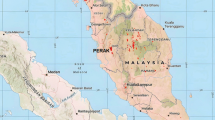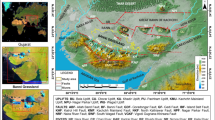Abstract
In June 1990 a research project sponsored by DANIDA and AWF was carried out by botany students of Nairobi University to investigate the regeneration strategy of mangroves at Gazi bay and Mida creek. Statistical analysis of 449 quadrats (5 × 5 m) sampled along 35 line transects in 4 mangrove forests showed that mangrove seedlings follow the same distribution pattern in the intertidal zone as their parent trees. In other words, mangrove seedlings mainly develop within a well-defined species specific zone. These distribution zones for the various mangrove trees and their seedlings are defined in terms of elevation above the mean low water level of spring tides.
Through assigning mangrove seedlings in the intertidal zone to the categories (i) ‘fixed’ or ‘not-fixed’, and (ii) ‘covered’ or ‘not-covered’, evidence was found that propagule dispersal followed both the ‘self-planting’ theory and the ‘stranding’ theory. The ‘self-planting’ theory appeared to be the major mechanism of propagule dispersal in ‘undisturbed’ mangrove forests, whilst the ‘stranding theory’ proved to be predominant in colonizing ‘over-exploited’ and cleared mangrove forests.
It is concluded that re-afforestation of mangrove seedlings in the intertidal zone will be most successful when the seedlings are planted in their specific distribution zones under fixed conditions.
Similar content being viewed by others
References
Beeckman, H., E. Gallin & E. Coppejans, 1990. Indirect gradient analysis of the mangal formation of Gazi Bay (Kenya). Silva Gandavensis 54: 57–72.
Chambers, J. M., W. S. Cleveland, B. Kleiner & P. A. Tukey, 1983. Graphical methods for data analysis. The Wadsworth statistics/probability series. Wadsworth International Group, Belmont, California. 395 pp.
Clarke, L. D. & N. J. Hannon, 1970. The mangrove swamp and salt marsh communities of the Sydney district. 3. Plant growth in relation to salinity and waterlogging. J. Ecol. 58: 351–369.
Coppejans, E. & E. Gallin, 1989. Macroalgae associated with the mangrove vegetation of Gazi Bay (Kenya). Bull. Soc. r. Bot. Belg. 122: 47–60.
Dawes, C. J., 1980. Marine Botany. John Wiley & Sons, New York. 628 pp.
Gallin, E., 1988. Vegetatie-ecologische studie van de mangrove langs de Westkust van Gazi Bay (Kenia). State University Ghent. M. Sc. Thesis, 157 pp.
Gallin, E., E. Coppejans & H. Beeckman, 1989. The mangrove vegetation of Gazi Bay. Bull. Soc. r. Bot. Belg. 122: 197–207.
Gang, P. O. & J. L. Agatsiva, 1990. The current status of mangroves along the Kenyan coast: a case study of the Mida Creek mangroves based on remote sensing. Paper presented at the International Symposium on Mangroves and related Ecosystems, 1990, Mombasa, Kenya.
Graham, R. M., 1929. Notes on the mangrove swamps of Kenya. J. E. Afr. U. Nat. Hist. Soc. 36: 157–164.
Hotelling, H., 1933. Analysis of a complex of statistical variables into principal components. J. Ed. Psych. 24: 417–441, 498–520.
Isaac, W. M. E. & F. M. N. Isaac, 1968. Marine botany of the Kenya coast. 3. General account of the environment, flora and vegetation. J. E. Afr. Nat. Hist. Soc. 27: 1–28.
Jongman, R. H. G., C. J. F. ter Braak & O. F. R. van Tongeren, 1987. Data analysis in community and landscape ecology. Pudoc, Wageningen. 299 pp.
Kokwaro, J. O., 1980. Economic importance and local use of the Kenyan mangroves. Proceedings of the Kenya National Seminar on Agroforestry, ICRAF, Nairobi: 377–386.
Kokwaro, J. O., 1985. The distribution and economic importance of the mangrove forests in Kenya. J. E. Afr. Nat. Hist. Soc. 75: 1–12.
MacNae, W. & M. Kalk, 1962. The ecology of the mangrove swamps at Inhaca island, Moçambique. J. Ecol. 50: 19–34.
Moorjani, S. A., 1977. The ecology of marine algae of the Kenya coast. University of Nairobi, Ph.D. Thesis. 285 pp.
Orlóci, L. & N. C. Kenkel, 1985. Introduction to data analysis. Statistical Ecology monographs 1. International Cooperative Publishing House, Maryland, USA. 339 pp.
Rabinowitz, D., 1978a. Dispersal properties of mangrove propagules. Biotropica 10: 47–57.
Rabinowitz, D., 1978b. Early growth of mangrove seedlings in Panama, and an hypothesis concerning the relationship of dispersal and zonation. J. Biogeogr. 5: 113–133.
Ruwa, R. K. & P. Polk. 1986. Additional information on mangrove distribution in Kenya: some observations and remarks. Kenya Journal of Science and Technology Series B 7(2): 41–45.
Ruwa, R. K., 1990a. The effects of habitat complexities created by mangroves on macrofaunal composition in brackishwater intertidal zones at the Kenyan coast. Discovery and Innovation 2: 49–55.
Ruwa, R. K., 1990b. Impact on mangroves and crabs in creek and fringe mangrove vegetation due to disturbances at the Kenyan coast. Paper presented at the International Symposium on Mangroves and related Ecosystems, 1990, Mombasa, Kenya.
Tomlinson, P. B., 1986. The botany of mangroves. Cambridge university Press Tropical Biology Series. 413 pp.
Van Speybroeck, D., 1990. Field course to the Kenya coast. June 1990. Report on the activities. University of Nairobi, Botany Department, internal report. 65 pp.
van der Maarel, E., 1979. Transformations of coverabundance values in phytosociology and its effects on community similarity. Vegetatio 39: 97–114.
Walter, H. & M. Steiner, 1936. The ecology of East African mangroves. Zeitschrift für Botanik 30.
Westhoff, V. & E. van der Maarel, 1978. The Braun-Blanquet approach. In: Whittaker, R. H. (ed.), Classification of plant communities. Dr W. Junk Publishers, The Hague: 287–399.
Author information
Authors and Affiliations
Rights and permissions
About this article
Cite this article
Van Speybroeck, D. Regeneration strategy of mangroves along the Kenya coast: a first approach. Hydrobiologia 247, 243–251 (1992). https://doi.org/10.1007/BF00008225
Issue Date:
DOI: https://doi.org/10.1007/BF00008225




